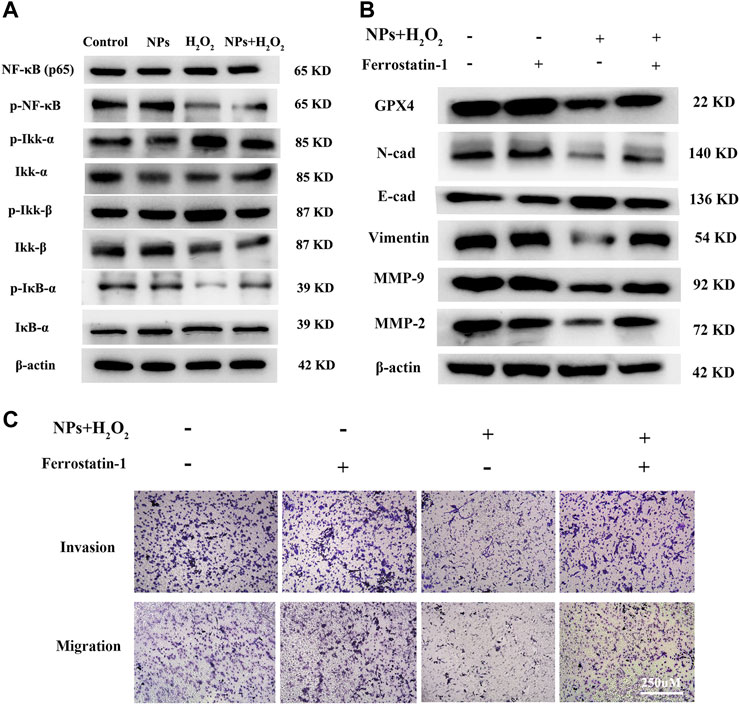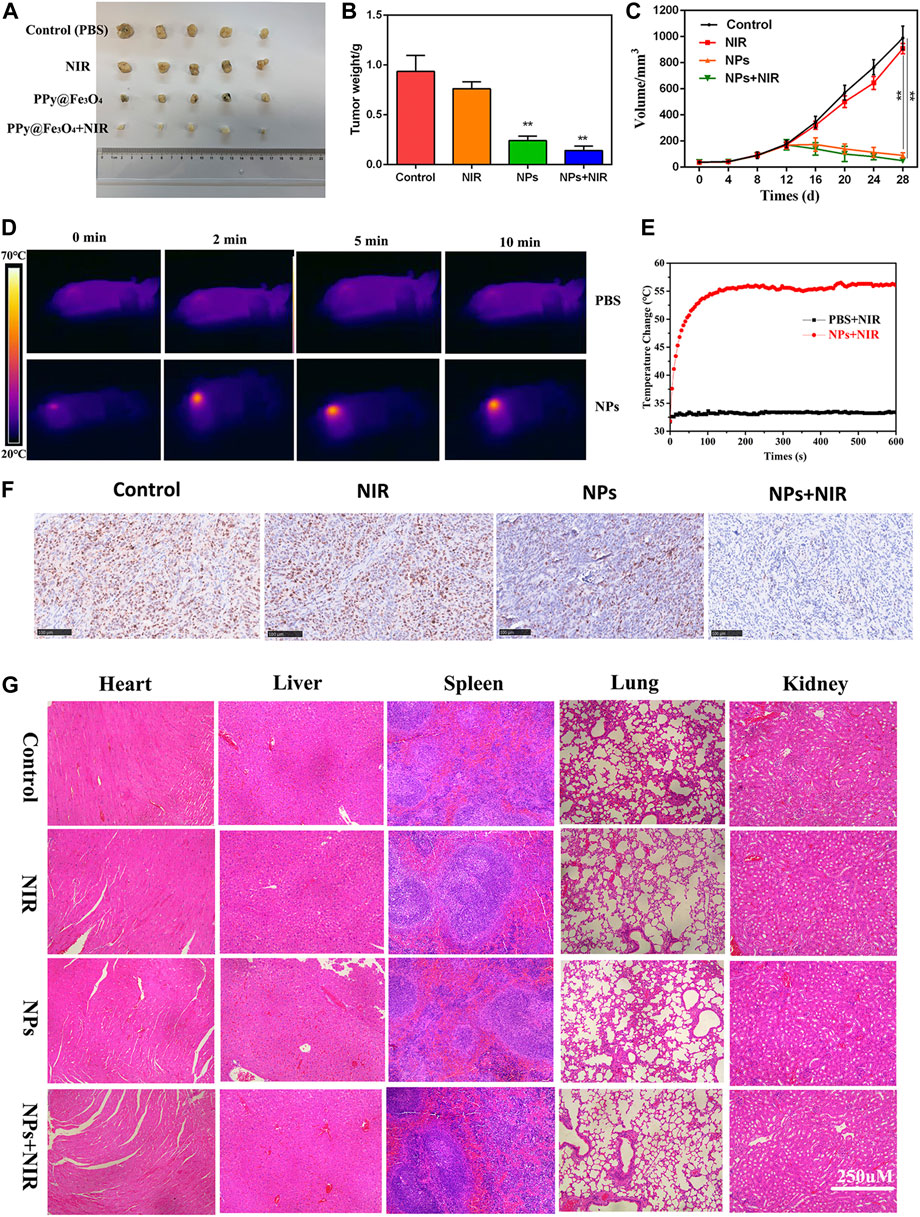
94% of researchers rate our articles as excellent or good
Learn more about the work of our research integrity team to safeguard the quality of each article we publish.
Find out more
CORRECTION article
Front. Bioeng. Biotechnol. , 01 December 2022
Sec. Nanobiotechnology
Volume 10 - 2022 | https://doi.org/10.3389/fbioe.2022.1094064
This article is a correction to:
PPy@Fe3O4 nanoparticles inhibit the proliferation and metastasis of CRC via suppressing the NF-κB signaling pathway and promoting ferroptosis
A Corrigendum on
PPy@Fe3O4 nanoparticles inhibit the proliferation and metastasis of CRC via suppressing the NF-κB signaling pathway and promoting ferroptosis
by Yu Z, Tong S, Wang C, Wu Z, Ye Y, Wang S and Jiang K (2022). Front. Bioeng. Biotechnol. 10:1001994. doi: 10.3389/fbioe.2022.1001994
In the published article, there was an error in the legend for Figure 6 as published. “DLD1” in Figure 6B Legend was incorrectly written as “MGC-803”. The corrected legend appears below.
In the published article, there was an error in Figure 5C and Figure 6B as published. “Invasion” was incorrectly written as “Invation”. The real image in the lower right corner of Figure 5C was incorrect due to a copy error when assembling the images. “NIR” in Figure 6B was incorrectly written as “H2O2”. “Control” in Figure 6F was incorrectly written as “Contol”. The corrected Figure 5 and Figure 6 and its caption appear below.

FIGURE 5. PPy@ Fe3O4 NPs suppress CRC cells metastasis by promoting cell ferroptosis and inhibiting NF-κB signaling pathway. (A) Western blot. Colorectal cancer cell line DLD1 was treated with various groups (Control, H2O2, NPs and NPs +H2O2), and then subjected to Western blot analysis of the key proteins of the NF-κB signaling pathway (Ikk-β, p-Ikk-β, Ikk-α, p-Ikk-α, NF-κB, p-NF-κB, iκB-α, and p-iκB-α). (B) Effects of the ferroptosis inhibitor Ferrostatin-1 on PPy@Fe3O4 NPs-induced metastasis-related proteins expression. (C) Transwell showed that PPy@Fe3O4 NPs induced cell migration and invasion were abolished after addition of the ferroptosis inhibitor Ferrostatin-1 in CRC cells.

FIGURE 6. Anti-tumour activity of PPy@ Fe3O4 NPs in nude mouse tumour cell xenografts. (A) Images of subcutaneous xenograft tumors of DLD1 cells. (B) The final tumor weight of DLD1 cells was shown. (C) The tumor volume and change of different groups. (D) The temperature change and (E) infrared thermal imaging of the mice injected with PBS, NPs under laser irradiation. (F) Ki67 staining of the tumors in the control group and other treated groups. (scale bar: 100 μm). (G) H&E staining of the main organs from the control and treatment groups. (scale bar: 250 μm). **p < 0.01.
The authors apologize for this error and state that this does not change the scientific conclusions of the article in any way. The original article has been updated.
All claims expressed in this article are solely those of the authors and do not necessarily represent those of their affiliated organizations, or those of the publisher, the editors and the reviewers. Any product that may be evaluated in this article, or claim that may be made by its manufacturer, is not guaranteed or endorsed by the publisher.
Keywords: colorectal cancer, nanoparticles, metastasis, NF-κB, ferroptosis
Citation: Yu Z, Tong S, Wang C, Wu Z, Ye Y, Wang S and Jiang K (2022) Corrigendum: Yu et al. PPy@Fe3O4 nanoparticles inhibit the proliferation and metastasis of CRC via suppressing the NF-κB signaling pathway and promoting ferroptosis. Front. Bioeng. Biotechnol. 10:1094064. doi: 10.3389/fbioe.2022.1094064
Received: 09 November 2022; Accepted: 21 November 2022;
Published: 01 December 2022.
Edited and reviewed by:
Yu Luo, Shanghai University of Engineering Sciences, ChinaCopyright © 2022 Yu, Tong, Wang, Wu, Ye, Wang and Jiang. This is an open-access article distributed under the terms of the Creative Commons Attribution License (CC BY). The use, distribution or reproduction in other forums is permitted, provided the original author(s) and the copyright owner(s) are credited and that the original publication in this journal is cited, in accordance with accepted academic practice. No use, distribution or reproduction is permitted which does not comply with these terms.
*Correspondence: Kewei Jiang, dr_jiangkewei@163.com
†These authors have contributed equally to this work
Disclaimer: All claims expressed in this article are solely those of the authors and do not necessarily represent those of their affiliated organizations, or those of the publisher, the editors and the reviewers. Any product that may be evaluated in this article or claim that may be made by its manufacturer is not guaranteed or endorsed by the publisher.
Research integrity at Frontiers

Learn more about the work of our research integrity team to safeguard the quality of each article we publish.